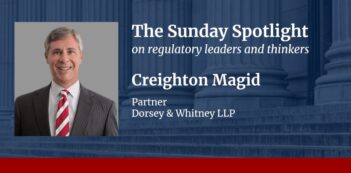
New position paper calls for climate change and sustainable energy regulations.
President Obama highlighted environmental regulation as a prominent issue for his second term when he promised to “respond to the threat of climate change” during his inaugural address. In a recent position paper, David Uhlmann, a professor at University of Michigan Law School, proposes a regulatory agenda to suggest how the president might address this threat, as well as other environmental concerns, during his second term.
Because of what he terms the “difficult politics of climate change”—namely opposition to environmental regulations due to a still-recovering economy and a lack of national consensus on environmental policies—Uhlmann points out that presidential environmental leadership is essential to furthering environmental regulation. Uhlmann urges the Obama administration to address climate change as a “top priority,” especially in light of Republican opposition to climate change legislation.
As new environmental legislation may be unlikely in the near future, Uhlmann urges the Obama administration to use executive orders and Environmental Protection Agency (EPA) regulatory actions under existing statutes to target climate change. Uhlmann also suggests that the administration could garner public support for environmental regulation by emphasizing Hurricane Sandy and other environmental disasters.
Uhlmann’s proposed regulatory agenda places climate change as its “center-piece,” noting that the “scientific verdict” that human behavior is causing the climate to change was settled years ago. He proposes a carbon tax as a way of both addressing climate change and raising revenue. According to Uhlmann, economists broadly support a carbon tax, and it would help reduce greenhouse gas emissions by creating business incentives to use renewable energy.
Uhlmann’s agenda also recommends a number of infrastructure investments. He provides several suggestions, including developing an electric smart grid, erecting “storm barriers” for communities prone to damage in hurricanes and extreme storms, improving waste treatment plants, and investing in sustainable transportation projects, like expansions to mass transit systems.
This agenda emphasizes a shift to renewable and sustainable energy to address climate change. Uhlmann suggests that the Obama administration could encourage these developments through tax credits for renewable energy to make green energy investments more cost effective. He also notes that hydraulic fracturing, a method of natural gas recovery commonly referred to as “fracking,” may offer a valuable domestic source of energy. Fracking could shift energy consumption away from dirtier forms of energy and towards cleaner domestic natural gas.
Although fracking is now subject to a patchwork of different state rules, Uhlmann suggests that the EPA should set baseline fracking regulations from which states could deviate to impose more, but not less, stringent rules. According to Uhlmann, federal regulation of fracking is necessary because the process may release methane, a greenhouse gas under the Clean Air Act, and cause interstate water contamination. However, with a 2005 law, Congress expressly excluded fracking from federal regulation under the Safe Drinking Water Act, so comprehensive regulation would require congressional action. Even without legislation on the issue, Uhlmann suggests that administrative agencies already have the power to regulate fracking on public lands and its effects on emissions and water pollution.
Finally, Uhlmann encourages the Obama administration to continue working on international environmental partnerships including the Climate and Clean Air Coalition and the Global Alliance for Clean Cookstoves. In addition, Uhlmann urges the administration to engage in more multilateral efforts on greenhouse emissions and climate change, such as the Major Economies Forum on Energy and Climate, a forum for seventeen of the world’s largest greenhouse gas-emitting countries.
Thus far, a number of legal challenges have created obstacles to regulatory actions under existing statutes. Just last year, for example, a federal appeals court struck down the Cross-State Air Pollution Rule, an EPA regulation under the Clean Air Act that would have established a regional cap-and-trade system for sulfur dioxide and nitrogen oxide to address the migration of air pollutants across state lines. Similarly, a Supreme Court decision involving a Clean Water Act regulation has placed the government’s regulatory reach under that statute into question. Uhlmann suggests that the Department of Justice can help the administration’s environmental efforts by vigorously defending government regulatory actions.
The American Constitution Society distributed Uhlmann’s paper as part of the organization’s issue brief series, “Toward a More Perfect Union: A Progressive Blueprint for the Second Term.”



